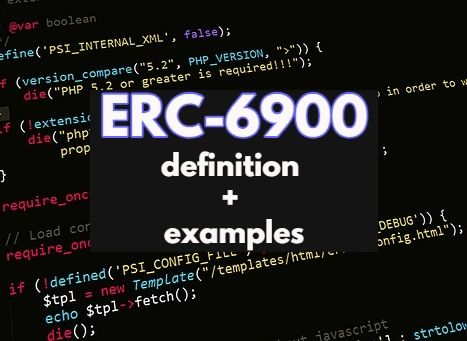ERC-6900 – definition and examples. Here’s what the ERC-6900 is, its features and benefits, and who it’s for.
ERC-6900 corresponds to an Ethereum standard deployed in April 2023.
We can say in a few words that ERC-6900 is a proposal for a token standard on Ethereum related to smart contract property management. Unlike well-known token standards (such as ERC-20 for fungible tokens and ERC-721 for non-fungible tokens), this standard focuses on smart contracts themselves.
ERC-6900 – introduction:
ERC-6900 introduces interesting features for smart contracts on the Ethereum blockchain. Here are some of its key features:
Modular smart contract accounts: the ERC-6900 enables smart contract accounts to be created by combining different modules. This offers increased flexibility to customize a contract’s functionality.
Account plugins: Plugins are modules that can be added to a smart contract account. They enable the account’s functionality to be extended without requiring modifications to the main contract.
Composable logic: Thanks to modular architecture, developers can compose complex functionalities by assembling existing modules. This facilitates the reuse and updating of functionality.
Interoperability: This standard aims to improve interoperability between smart contracts and DeFi (decentralized finance) protocols, enabling smoother interactions.
Scalability: By using modules, smart contracts can evolve more easily without disrupting existing functionality.
Some projects, such as Gaudiy Lab’s, have already begun to develop a portfolio of smart contracts. In the case of Gaudiy Lab, they use the ERC-4337 and ERC-6900.
3 significant advantages and who benefits from them:
1. Flexibility for developers :
- Benefit: This standard enables developers to create modular smart contracts by combining different plug-ins. This offers greater flexibility in customizing the functionality of a contract.
- Benefit: DeFi (decentralized finance) application developers, blockchain project teams and smart contract auditors take advantage of this flexibility to create more robust and scalable solutions.
2. Reduced “Vendor Lock-in”:
- Benefit: This standard solves the problem of “Vendor Lock-in”, where smart contracts are tied to specific implementations. Thanks to modularity, portfolios can incorporate new functions without depending on a single supplier.
- Beneficiaries: Wallet users, DeFi protocol developers and companies wishing to avoid the risks associated with dependence on a specific vendor.
3. Enhanced interoperability :
- Benefit: This standard facilitates interoperability between smart contracts and DeFi protocols. Standardized plug-ins enable smoother interactions between different applications.
- Beneficiaries: DeFi users, cash aggregators and projects seeking to create interconnected ecosystems.
What are the drawbacks of the ERC-6900?
Here are some of the potential drawbacks:
- Increased complexity: The modularity introduced by the ERC-6900 can make smart contracts more complex. Developers need to manage the interactions between different modules, which can increase the attack surface and require special attention during auditing.
- Gradual adoption: As ERC-6900 is relatively recent, its adoption is not yet widespread. Some projects may be reluctant to migrate to this standard due to the cost of upgrading and the need to carefully test new features.
- Compatibility with existing portfolios: Existing portfolios may not natively support ERC-6900. Users may have to wait for their preferred wallets to integrate this standard to take full advantage of its benefits.
To sum up, although the standard offers some interesting features, it’s essential to assess its drawbacks and potential problems when you’re still designing smart contracts.
Use cases:
- Rights Management Contracts: Define and manage specific rights to digital resources.
- Marketplace Contracts: Facilitate the exchange and management of goods and services with standardized properties.
- Governance Contracts: Manage properties linked to roles and permissions in decentralized governance systems.
In summary, ERC-6900 provides a standardized framework for defining and managing properties on Ethereum smart contracts, enhancing the interoperability and flexibility of smart contracts in the blockchain ecosystem.
